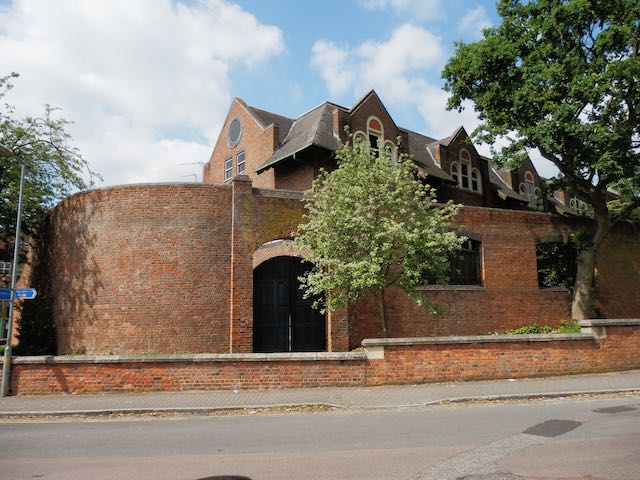The County Prison in Grimston Road was completed and opened shortly before the railway station next door. The field in which it was built was considerably larger than the boundary wall of the prison, and was known thereafter as the Gaol Field. Subsequently purchased by Frederick Sander, the orchid breeder, Gaol Field was sold on for residential development following Sander's death. The roads are now Edward Close, Breakspear Road, Flora Grove and Vanda Crescent, and more recently Ulverston Close.
The first housing, however, took advantage of the nearby railway station location, many of their residents being the among line's first commuters. When you research an Ordnance Survey map dating from the period when the prison was open, you will find the boundary wall and gatehouse drawn but a blank space within the wall. In the interests of security the cell blocks and other buildings within the perimeter wall were not published. |
| The original perimeter wall at the south-east corner remains, but buildings occupying the inside space are replacements for modern use. |
The 1841 census shows Ellen Wheeler living at Gustard Wood with her four children including 6 year old Thomas. So he was from a local family and undoubtedly grew up acutely familiar with the villages and countryside around him.
Once again we are provided with trial documents from newspapers; further, we were able to discover more about the prisoner's character, possibly because Wheeler attracted the attention of the Press and in the days before press photography a good journalist was able to pencil a character sketch in words. Wheeler, we are informed was five foot and one inch tall and in his mid forties. His hair was light brown, already turning grey, and he sported a moustache. At the trial he wore a bowler hat, which, at the time was generally known as a billycock. A short brown jacket and brown corded trousers completed his description. Other features were often not referred to, although one witness had observed that Wheeler's voice was "extremely peculiar". This, on its own, does not tell us much, but the witness might have been hearing a stammer, damaged vocal chords or a hair lip. We don't know.
Wheeler was born in Wheathampstead but had spent an extended period of time in London, where he had, the court was informed, a considerable amount of money taken from him and was determined to recover it. Of course, the use of the word "taken" instead of stolen might lead us to believe that the money may not have been his to begin with.
In returning to his home patch, Wheeler had visited a number of farms near St Albans, perhaps because of the remoteness of the buildings, at each of which he had broken in and stolen cash or other property. A pattern of behaviour had been established about which the police had been aware.
 |
| A pencilled sketch of Marshalswick Farm, previously known as Wheeler's Farm. Drawn by Jane Marten c 1826. The farm lay behind today's The Quadrant shops. COURTESY HISTORIC ENGLAND |
Wheeler's arrival on the upper floor attracted Anstee's attention. Certainly, if previous activity was anything to go by, Wheeler was intent on acquiring money and or possessions, but he was willing and prepared to take a life, or lives, if necessary. We will never know what conversation, if any, took place between the two men, but the result was a total of 37 gunshots in the farmer's body which, the court was informed, greatly disfigured his face. The violence also frightened two women in the house at the time, but we are not informed of their identities.
Property from Wheeler's visit was later discovered and recognised on Deadwoman's Hill, now known as Sandridge Road (near the Beech Road junction). Other locations were Evan's Farm (now the former Jersey Farm), and hidden in piles of straw on Ninefields. Today the latter would be just north of Brampton Road.
The police had called on Thomas Cooper of London Road to take photographs of the crime scene. His son was Arthur Melbourne Cooper who became well known as an early film maker. However, Arthur thought the pictures his father had taken didn't reflect the measure of the gruesome scene, and "doctored" some of the negatives accordingly. Which today would presumably have been referred to as tampering with the evidence, putting him in line to receiving a fine himself!
Wheeler was committed for trial at Chelmsford, was found guilty and executed at the prison in St Albans. Throughout, he had expressed his innocence – "not me guv, you've got the wrong bloke" may have been his defensive approach; however, he wrote a letter of apology to Mrs Anstee in which he admitted his guilt. It appears that Edward Anstee's wife was absent from the farmhouse on the night of the attack on her husband. She was, it is thought, visiting a relative and would probably have returned home the following day.
Nick Connell, in his book about Hertfordshire murders adds three footnotes: first, the cost on public funds of the execution was £20. Second, the traditional tolling of the parish church bell was at St Peter's. It would be another 20 years before the little church would be open at Stanhope Road and nearly thirty years before the new parish church of St Paul's in Blandford Road.
And finally, it was revealed that Wheeler had a daughter, Mary, who was fourteen at the time of her father's execution. She was seemingly much affected by the events surrounding her father and attempted to hang herself at a tree in her garden. Around ten years later she too was executed for the murder of another young woman. It was reported there had been a jealous relationship battle between them over a mutual male.




No comments:
Post a Comment